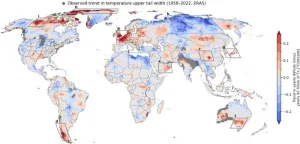(Press-News.org) With 2024 on track to be declared the hottest on record, scientists from IIASA and Columbia University have noticed that specific regions are consistently more affected by extreme temperatures. A new study provides the first worldwide map of these regional climate danger zones.
Amid the continued upward march in average temperatures over the past decades, a recent surge of record shattering extreme heat waves raise questions about the degree to which climate models can provide adequate estimates of relations between global mean temperature changes and regional climate risks. The study just published in the Proceedings of the National Academy of Sciences (PNAS) provides the first worldwide map of high-risk regions.
“This is about extreme trends that are the outcome of physical interactions we might not completely understand,” explains lead author Kai Kornhuber, Theme Lead on Weather Extremes and Climate Dynamics in the IIASA Energy, Climate, and Environment Program. “These regions become temporary hothouses.” Kornhuber is also an adjunct assistant Professor of Climate at the Columbia Climate School.
The study looks at heat waves over the past 65 years, identifying areas where extreme heat is accelerating considerably faster than typical warm-season temperatures overall. This often results in maximum temperature records that have been repeatedly broken. These extreme heat waves have been hitting predominantly in the last five years, although some occurred in the early 2000s or before.
The most hard-hit regions include central China, Japan, Korea, the Arabian Peninsula, eastern Australia and parts of South America and the Arctic. The most intense and consistent signal, however, comes from northwestern Europe, where sequences of heat waves contributed to around 60,000 deaths in 2022 and 47,000 in 2023. These occurred across Germany, France, the United Kingdom, and the Netherlands among others. In September this year, new maximum temperature records were set in Austria, France, Hungary, Slovenia, Norway and Sweden. Many parts of the United States Southwest and California also saw record temperatures well into October.
In these regions, extreme temperatures are increasing faster than average summer temperatures, at a rate far higher than what state-of-the art climate models have been projecting for the past few decades. The phenomenon is however not happening everywhere; the study shows that the increase in temperatures across many other regions is lower than what models would predict. These include wide areas of the north-central United States and south-central Canada, interior parts of South America, much of Siberia, northern Africa and northern Australia.
“In most areas, the hottest days of the year are warming about as fast as typical summertime days, which is the dominant signal of climate change, and in some areas even slower. In the hotspots that we point out, however, the hottest days have been warming particularly fast, which could be for various reasons. In some places there could be more occurrences of specific heatwave-inducing weather patterns, or soil drying could be amplifying the hottest temperatures—and it will be important to untangle these specific local drivers,” says coauthor Samuel Bartusek, a PhD candidate at the Columbia University.
“Due to their unprecedented nature, these heat waves are usually linked to very severe health impacts, and can be disastrous for agriculture, vegetation, and infrastructure,” adds Kornhuber. “We’re not built for them, and we might not be able to adapt fast enough.”
This study is an important first step towards addressing the emerging risk from extreme and unprecedented heat by identifying regions that have historically faced rapidly increasing risk and quantifying the ability of models to reproduce these signals.
Reference
Kornhuber, K., Bartusek, S., Seager, R., Schellnhuber, H.J., Ting, M. (2024). Global emergence of regional heatwave hotspots outpaces climate model simulations. Proceedings of the National Academy of Sciences (PNAS) DOI: 10.1073/pnas.2411258121
About IIASA:
The International Institute for Applied Systems Analysis (IIASA) is an international scientific institute that conducts research into the critical issues of global environmental, economic, technological, and social change that we face in the twenty-first century. Our findings provide valuable options to policymakers to shape the future of our changing world. IIASA is independent and funded by prestigious research funding agencies in Africa, the Americas, Asia, and Europe. www.iiasa.ac.at
END
Mapping the world's climate danger zones
2024-11-26
ELSE PRESS RELEASES FROM THIS DATE:
Emory heart team implants new blood-pumping device for first time in U.S.
2024-11-26
On Nov. 18, the heart failure and transplantation team at Emory University Hospital (EUH) made history, performing the first-ever surgical implantation in the United States of a brand-new type of ventricular assist device (VAD), which provides crucial care to patients with failing hearts.
An expert team led by veteran cardiothoracic surgeon Mani Daneshmand, MD, successfully implanted a novel magnetically levitated pump, a VAD that has been specifically designed for patient ease and long-term health. The BrioVAD System, made by BrioHealth Solutions Inc., was authorized by the FDA to begin clinical trials ...
Congenital heart defects caused by problems with placenta
2024-11-26
Congenital heart defects are the most common form of human birth defect, but we still don’t fully understand what causes them. Previous research had suggested that some heart defects could be triggered by problems with the placenta, the organ that provides oxygen and nutrients to the developing embryo. Now, researchers at Nanjing University, China have confirmed this link by focusing on a protein whose levels are reduced in many patients with congenital heart defects, called SLC25A1. SLC25A1 plays a key role in transporting ...
Schlechter named Cancer Moonshot Scholar
2024-11-26
Chelsey Schlechter, MPH, PhD, Huntsman Cancer Institute investigator and assistant professor in the Department of Population Health Sciences at the University of Utah (the U), has been selected as a Cancer Moonshot Scholar.
Schlechter is one of only eleven researchers in the U.S. chosen for the prestigious program this year, which aims to both advance impactful cancer research and broaden the research workforce.
For the project, Schlechter and her team partnered with the Association for Utah Community Health and Utah Community Health Centers—organizations which ...
Two-way water transfers can ensure reliability, save money for urban and agricultural users during drought in Western U.S., new study shows
2024-11-26
A new study led by researchers at the University of North Carolina at Chapel Hill offers a solution to water scarcity during droughts amid the tug of economic development, population growth and climate uncertainty for water users in Western U.S. states. The proposed two-way leasing contracts would coordinate agricultural-to-urban leasing during periods of drought and urban-to-agricultural leasing during wet periods, benefiting both urban and agricultural water users.
“Water markets are an important tool for allocating water in the Western U.S., and other water-scarce regions around the world, but they are often slow to respond to drought, ...
New issue of advances in dental research explores the role of women in dental, clinical, and translational research
2024-11-26
Alexandria, VA, USA - The Journal of Dental Research (JDR) has announced the publication of a new issue of Advances in Dental Research, a supplement to the Journal of Dental Research (JDR), entitled, "Women in Dental, Clinical, and Translational Research.”
The 2024 Annual Meeting of the American Association for Dental, Oral, and Craniofacial Research (AADOCR) and the Canadian Association for Dental Research featured a two-day “Meeting Within a Meeting” on the topic of “Women in Dental, Clinical, and Translational Research” organized by AADOCR Then- President Alexandre Vieira. During these sessions, speakers were challenged to reflect on ...
Team unlocks new insights on pulsar signals
2024-11-26
Team Unlocks New Insights on Pulsar Signals
November 26, 2024, Mountain View, CA – Dr. Sofia Sheikh from the SETI Institute led a study that sheds new light on how pulsar signals—the spinning remnants of massive stars—distort as they travel through space. This study, published in The Astrophysical Journal, was performed by a multi-year cohort of undergraduate researchers in the Penn State branch of the Pulsar Search Collaboratory student club. Maura McLaughlin, Chair, Eberly Distinguished Professor of Physics and Astronomy, West Virginia University, created the Pulsar Search Collaboratory to engage ...
Great apes visually track subject-object relationships like humans do
2024-11-26
Great apes track events with their eyes in the same way that humans do, according to a study published November 26th in the open-access journal PLOS Biology by Vanessa Wilson from the University of Neuchatel, Switzerland, and colleagues.
When watching a cat chase a mouse, humans will alternate looking at cat and mouse, using the information to connect the two into what’s called an agent-patient relationship—with the cat as the agent and the mouse as the patient. This cognitive mechanism is thought to be ...
Recovery of testing for heart disease risk factors post-COVID remains patchy
2024-11-26
Routine screening to detect risk factors for heart disease dropped sharply during the COVID-19 pandemic in England, and some key measurements, such as blood pressure readings, may still lag behind pre-pandemic levels. These findings are reported in a new study by Frederick Ho and Naveed Sattar of the University of Glasgow, Scotland, UK, and colleagues published November 26th in the open-access journal PLOS Medicine.
During the COVID-19 pandemic, patients went without routine face-to-face health checks, which are important for detecting common cardiometabolic ...
Final data and undiscovered images from NASA’s NEOWISE
2024-11-26
While NASA’s NEOWISE telescope ended its journey through space on Nov. 1, 2024, the team at IPAC, a science center at Caltech, was working on one further gift from the prolific mission.
The final data release from NEOWISE was released to the astronomy community just two weeks later, on Nov. 14, encompassing over 26 million images and nearly 200 billion sources detected by the telescope. And today, IPAC is releasing six new images from the mission’s archival data as a tribute to this landmark project, available here: https://www.astropix.org/link/3b2x
NEOWISE ...
Nucleoporin93: A silent protector in vascular health
2024-11-26
"Research in the last several decades has established endothelial cells (ECs) as a dynamic interface critical for vascular protection.”
BUFFALO, NY- November 26, 2024 – This editorial was published by Aging (listed by MEDLINE/PubMed as "Aging (Albany NY)" and "Aging-US" by Web of Science) in Volume 16, Issue 17, titled, “The silent protector: Nucleoporin93’s role in vascular health.”
Written by Julia Michalkiewicz, Tung D. Nguyen, and Monica Y. Lee from The University of Illinois at Chicago College of Medicine, ...






